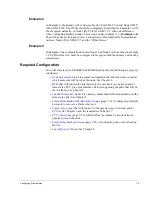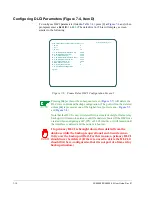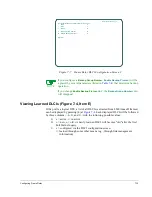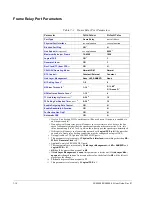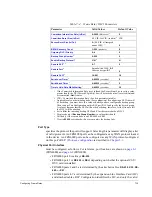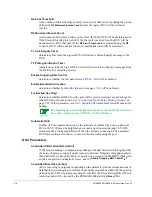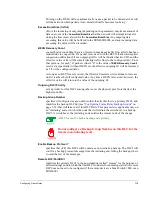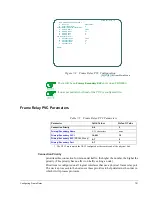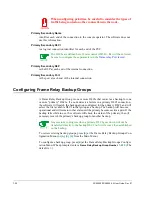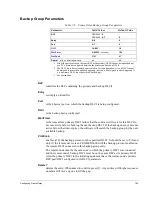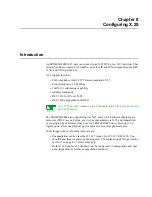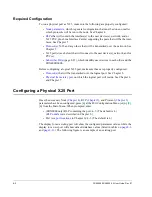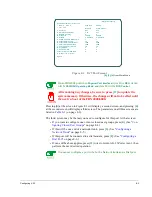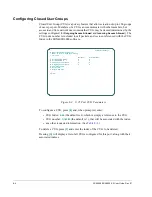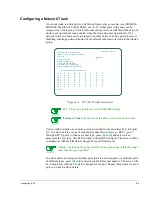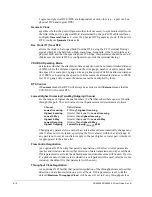
Configuring Frame Relay
7-19
Turning on the DE bit will not automatically cause a packet to be discarded, but will
tell the network which packets it can discard if traffic becomes too heavy.
Excess Burst Size (In/Out)
(B
E
) is the incoming or outgoing (depending on the parameter) maximum amount of
data in excess of the
Committed Burst Size
that the network will attempt to transfer
during the time interval used for the
Committed Burst Size
. Any outgoing data
exceeding this value will be buffered in the FRX4000/6000, and any incoming data
exceeding the value will be discarded.
BECN Recovery Count
is a method of controlling the rate of return to maximum traffic flow after it has been
reduced due to congestion. If a packet is received with the BECN (backward explicit
congestion notification) bit set, outgoing traffic will be throttled back to CIR, and the
effective value of B
E
will become
0
(limting traffic flow to the configured B
C
). From
that point on, for each "n" packets (where "n" is the value of
BECN Recovery Count
)
received (sequentially) without BECN set, the effective outgoing B
E
will be increased
by 1/8 of the configured value.
As long as no BECNs are received, the effective burst size will continue to increase
until it reaches the full configured value. Any time a BECN is received, however, the
effective value will return to the value of the outgoing B
C
.
Outgoing DLCI Priority
sets a priority for this DLCI among others over the physical port. Note that
4
is the
highest priority.
Backup Group Number
specifies (if configured as any number other than
0
) that this is a primary DLCI, and
identifies the backup DLCI(s) (see "
Configuring Frame Relay Backup Groups
" on
page 7-22) that will take over if this DLCI fails. This parameter is applicable only on
an "initiating" node, which is the node that will initiate the switchover to a backup
DLCI. At switchover, the initiating node notifies the remote node of the change.
A DLCI cannot be both a backup and a primary.
Do not configure a Backup Group Number on this DLCI at the
remote (non-initiating) end.
Enable Backup Protocol?
specifies that (if
Y
) this DLCI will be used as a non-initiating backup. The DLCI will
wait for a backup protocol message from the initiating end, telling the backup where
to send the rest of the messages.
Remote RLP/Port/DLCI
identifies the primary DLCI in the non-initiating (called "remote" for the purpose of
differentiating) node to which that this DLCI connects for normal operation.(A remote
RLP does not need to be configured if the remote device is a SmartSwitch 1800 or an
FRX4000.)
Содержание Netlink FRX4000
Страница 2: ......
Страница 16: ...xiv FRX4000 FRX6000 4 0 User Guide Rev 01 ...
Страница 17: ...Section I Getting Started ...
Страница 18: ......
Страница 24: ......
Страница 37: ...Section II Configuration ...
Страница 38: ......
Страница 52: ......
Страница 78: ......
Страница 106: ...7 24 FRX4000 FRX6000 4 0 User Guide Rev 01 ...
Страница 142: ...8 36 FRX4000 FRX6000 4 0 User Guide Rev 01 ...
Страница 186: ......
Страница 216: ......
Страница 266: ......
Страница 273: ...Section III Operation ...
Страница 274: ......
Страница 296: ......
Страница 324: ......
Страница 376: ......
Страница 377: ...Section IV Appendices ...
Страница 378: ......
Страница 384: ......
Страница 390: ......
Страница 396: ......
Страница 400: ......
Страница 405: ...Menu Structure E 5 ...
Страница 406: ...E 6 FRX4000 FRX6000 4 0 User Guide Rev 01 ...
Страница 425: ......
Страница 426: ......

